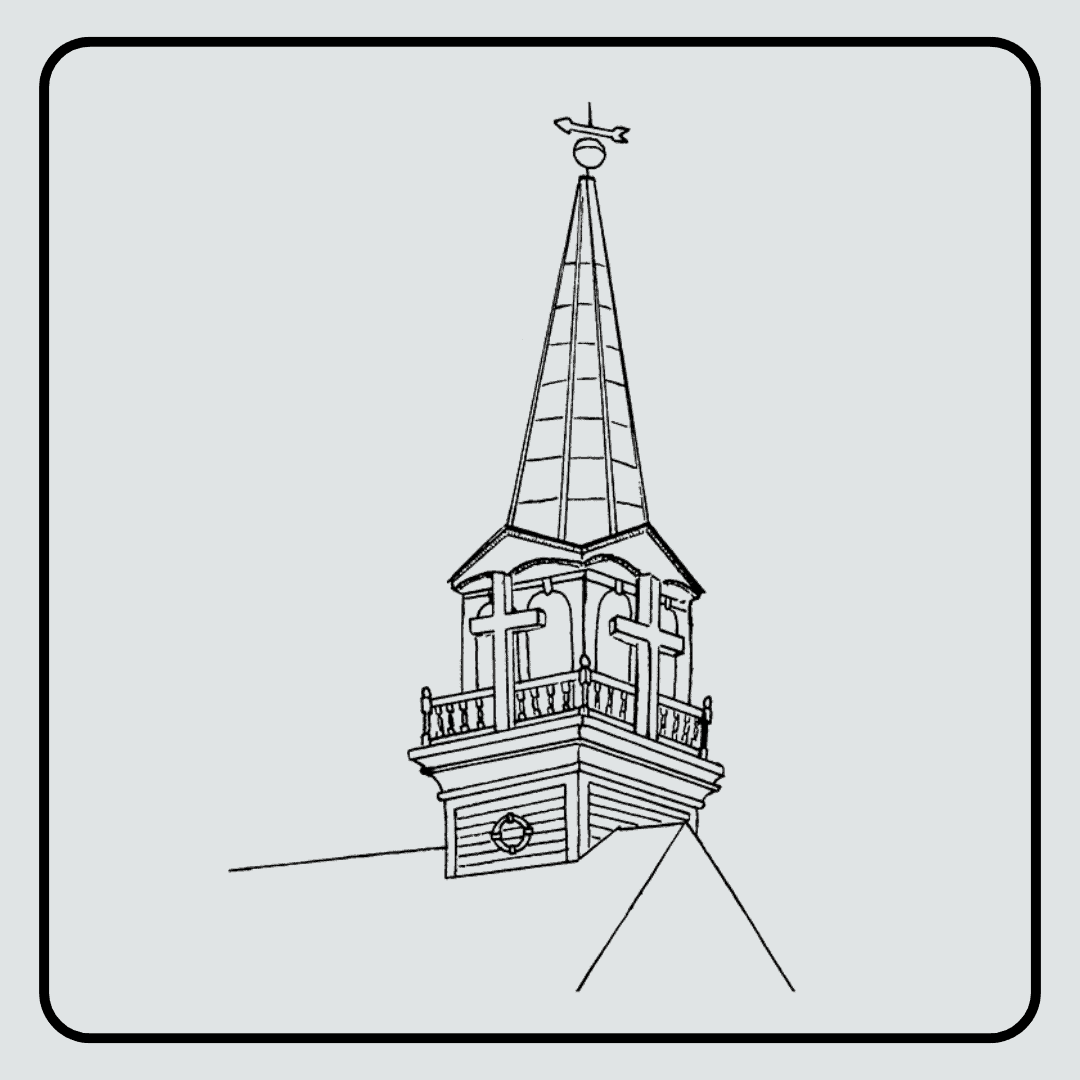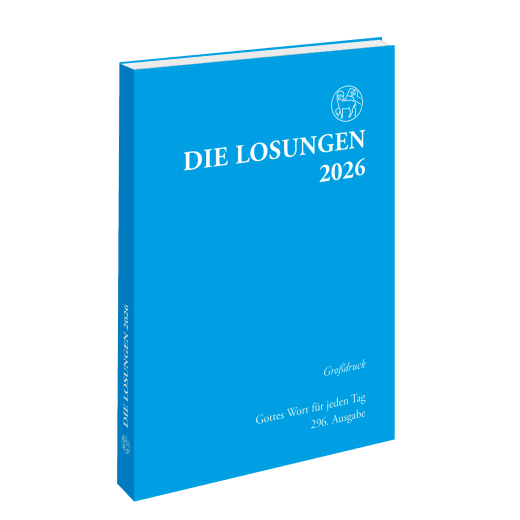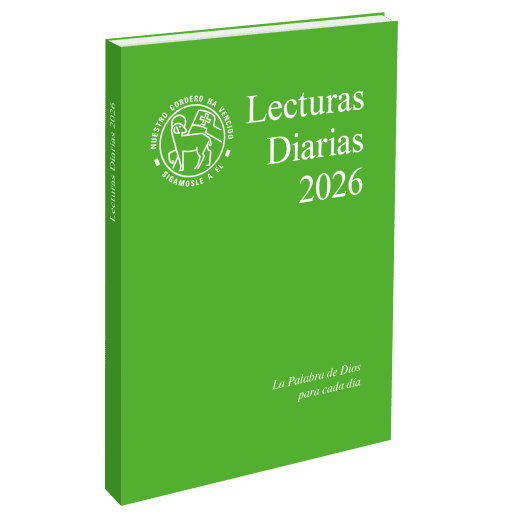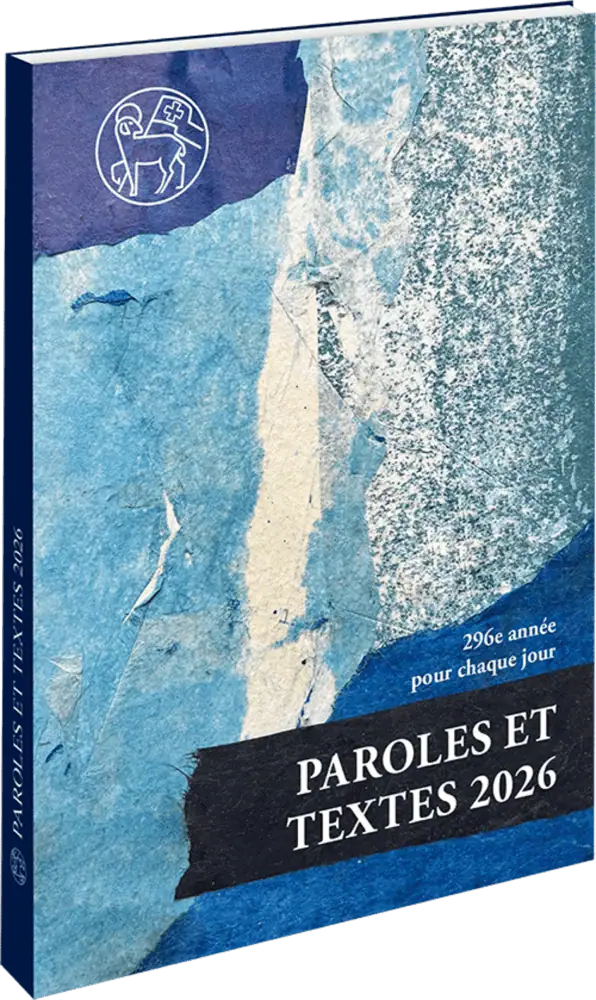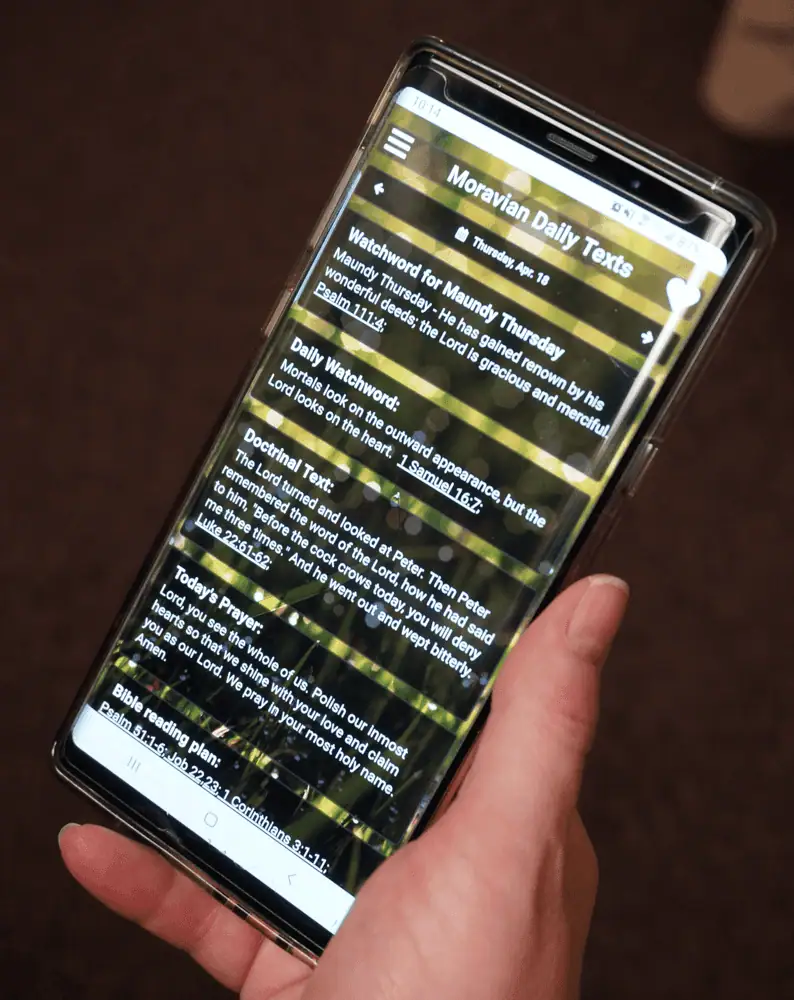Imagine sharing the same devotional guide with almost 2 million believers in more than 60 languages around the globe. The Moravian Daily Texts has been living this ecumenical dream for almost three centuries!
The Moravian Daily Texts (or Losungen) is a daily devotional guide published yearly since 1731. It is the oldest such guide in continuous use. Begun in Germany as a daily oral tradition, it soon became a regularly printed set of texts for each day of the year. The Losungen are a way of connecting God’s word with our everyday lives. They can be a first step in getting to know the Bible in all its breadth and depth.

The first printed edition of the Losungen was published in Herrnhut, Saxony, in 1731. Since then, the Daily Texts have been published without interruption, year after year. With the start of the Moravian missionary work in 1732, the course was set for the worldwide distribution of the Daily Texts. Today, more than 290 years after its first publication, the Moravian Daily Texts continues its promise of “a daily message from God that is new every morning.”
For guidelines on using the Moravian Daily Texts as a daily devotion, please click here.
History of the Daily Texts
In 1722 refugees from Bohemia and Moravia began arriving at the estate of Count Nicholas Ludwig von Zinzendorf, where he gave them a warm welcome and land on which to establish the settlement of Herrnhut. The Daily Texts are an outgrowth of a spiritual renewal of the Moravian Church (Unitas Fratrum) that began on August 13, 1727.
Each day the Herrnhut community came together for morning and evening devotions, consciously placing their lives in the context of God’s Word. On May 3, 1728, during the evening service, Count Zinzendorf gave the congregation the verse of the song “Love drove him here, love tore him from the throne, and should we not love him?” It was to be a “Losung” (watchword) to accompany them through the whole next day.
Soon such a watchword was being issued daily in Herrnhut. Zinzendorf called the watchwords “continued conversations between the Savior and the congregation.” One or more members of the congregation went daily to each of the 32 houses in Herrnhut to bring them the watchword for the day and engage the families in pastoral conversations about the text.

From this oral tradition, the Losungen soon became fixed in printed form. Zinzendorf compiled 365 watchwords for the year and the first edition of the Losungen was published for 1731. The title page of that edition quoted this passage from Lamentations 3:22-23, “The steadfast love of the Lord never ceases, his mercies never come to an end; they are new every morning.”
Even in the first editions there appeared the characteristic coupling of a Bible verse and hymn stanza. Zinzendorf called the hymns “collects” and considered them to be the answer of the congregation to the Word of God. The Daily Texts would be a great deal poorer without the mixture of God’s Word and our human response.
The watchword soon became accompanied by a “doctrinal” text. The idea of an additional text grew out of a number of collections of texts from the Bible that were put together by Zinzendorf. Such additional lists (some of them for children) were used for special study within the groups in the community, and they came to be referred to as doctrinal texts.
For the Daily Texts, as for the whole Moravian Church, Count Zinzendorf’s death on May 9, 1760 was a turning point. His co-workers sensed the uniqueness of Zinzendorf’s watchwords, textbooks, and lessons and had them published at Barby-on-the-Elbe in a four-volume collection in 1762.
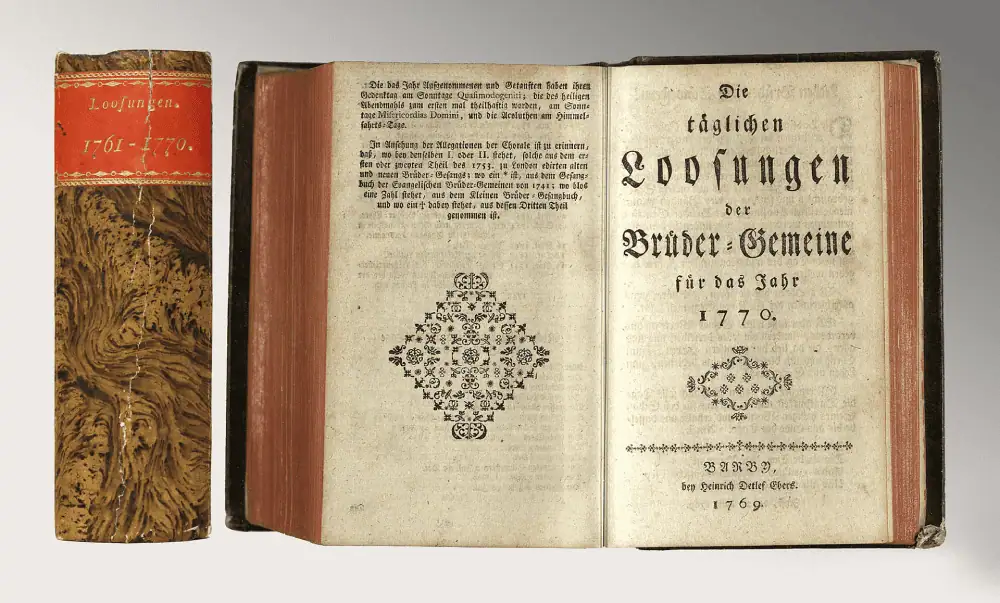
Creating A New Edition
Every year in spring, the Moravian Daily Texts for the year-after-next are drawn in Herrnhut. The three-year lead time is needed primarily because the Losungen must then be translated into more than 60 languages. For example, the Daily Texts for 2027 were drawn on April 24, 2024.
The watchwords and doctrinal texts are distinguished by the way they are selected each year. By 1812 it was established that all watchwords would be drawn by lot from a selection of Old Testament texts, and the doctrinal texts would be selected from the New Testament.
The difference between the watchwords and doctrinal texts was explained in 1801 as follows: “The watchword is either a promise, an encouragement, an admonition or word of comfort; the doctrinal text contains a point of revealed doctrine.” By the end of the nineteenth century, the custom was established to relate the two texts in theme or thought.
Since 1788, the watchwords have been drawn by lot from a collection of around 1,824 suitable Old Testament texts. Since the watchword from the last two years of daily texts are on hiatus, there are only around 1,100 cards in the watchwords bowl.
The Daily Texts are not subject to any iron law. The Old Testament texts are reviewed by a committee at regular intervals. Suggestions for new watchwords are processed, and previously known texts are removed if, for example, their meaning can be interpreted too one-sidedly or is no longer understandable.

The drawing of the daily texts always takes place in Herrnhut, in a small hall in the “Vogtshof”, the seat of the church leadership of the Evangelische Brüder-Unität (Evangelical Unity of the Brethren). The members of the church leadership and other employees take part in the drawing of the mottos. The daily texts for a year are drawn day by day from January 1st to December 31st and then sent around the world to those who prepare the different language editions.
Moravian Daily Texts Around The World
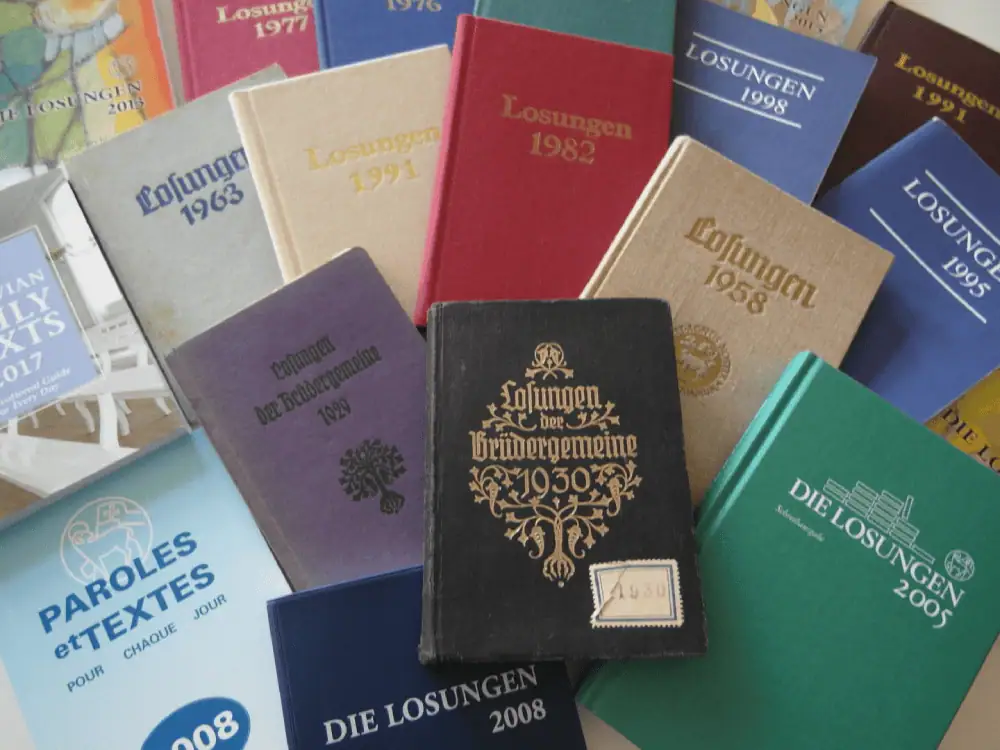
The watchwords connect Christians in more than 100 countries. They create an international community across denominational, traditional, and language boundaries. Reading the watchwords unites people with different levels of piety. Many readers find the unifying power of the watchwords particularly important. All editions are published in their respective countries.
The physical form of the Daily Texts varies considerably from country to country. Some, like the North American edition, have a separate page for the verses, hymns, and prayers of each day. Others have several days’ texts printed on one page, which makes a thin, pocket-size volume. Some are beautiful examples of the printing and bookbinding arts. Others are simply photocopied and stapled together.
These external non-essentials pale beside the fact that this little book is probably the most widely read devotional guide in the world, next to the Bible. It forms an invisible bond between Christians on all continents, transcending barriers of confession, race, language, and politics. In its quiet way it performs a truly ecumenical service for the whole of Christendom.
North American Editions
The printing of the Daily Texts in North America dates back at least to 1767, when the Losungen was printed “at Bethlehem on the Forks of the Delaware by Johan Brandmuller.” The printer’s imprint bears the date of 1767 as well and may have been an extra printing for the German version done at Barby-on-the-Elbe in Germany, where most of the printing was done for the Moravian Church those days.
During the chaotic days of the American Revolution, the German-language edition was printed in Philadelphia by Heinrich Miller, who had worked for Benjamin Franklin when he first came to America. The daily text for July 4, 1776, was from Isaiah 55:5 “Behold, you shall call nations that you know not, and nations that knew you not shall run to you” (RSV).
English versions were printed in London as early as 1746, and the title page bears the imprint of “James Hutton near the Golden Lion in Fetter Lane.” Hutton was the well-known London printer associated with the Moravian Church who was a friend of John and Charles Wesley in the formative years of their ministry.
The 1850s were crucial years for the Moravian Church in North America as the congregations established in the United States broke away from direct control from the Moravian headquarters in Europe. Both German and English editions of the Daily Texts were regularly printed in Philadelphia or Bethlehem, Pennsylvania and in a few years the custom was established to include the statistics of the provinces and districts of the Moravian Church in North America.
Since 1959 the edition published in the United States has included a prayer for each day. For the North American edition, the hymns are chosen or written, and the prayers are written by Moravian clergy and laypersons from the United States and Canada. Each month is prepared by a different individual or couple, of a variety of ages, so that the prayers reflect the great diversity of devotion in the Moravian Church.
62 Languages & Counting!
The process of selecting the Daily Texts takes place annually in Herrnhut, on behalf of the world-wide Unitas Fratrum, and from there the texts are distributed to each Province, to be reproduced in a form suited to local needs. Translated into more than 60 languages, the Moravian Daily Texts continue to be used and appreciated far beyond the membership of the Moravian Church. As Moravians we regard this wider ministry as a God-given privilege — an ecumenical ministry of the worldwide Moravian Unity that transcends confessional, political, and racial barriers of all kinds.

The Moravian Daily Texts are published in: Afrikaans, Albanian, Arabic, Basaa (Cameroon), Bemba (Zambia), Burmese (Myanmar), Bulgarian, Chichewa (Malawi), Chinese, Chin-Zotung (Myanmar), Danish, English, Estonian, Farsi (Persian), Finnish, French, Georgian, Hindi (India), Indonesian, Inuktetuk (Labrador), Icelandic, Italian, Japanese, Kinyarwanda (Rwanda), Kirundi (Burundi), Korean, Croatian, Ladakhi (India), Latvian, Mayangna (Nicaragua), Miskito (Honduras and Nicaragua), Nepali (India), Oriya (India), Oshivambo (Namibia), (Se-)Pedi (South Africa), Low German, Polish, Portuguese (Brazil), Rongmei Naga (India), Romanian, Russian, Swedish, (Se-Sotho (South Africa), Slovak, Lower Sorbian & Upper Sorbian, Spanish, Sranan Tongo (Suriname), Swahili or Kiswahili (Tanzania), (Si-)Swati (South Africa), Timbuku (Malawi), Tok Pisin (Papua New Guinea), Czech, (Se-)Tswana (South Africa), Hungarian, Ukrainian, (Thsi-)Venda (South Africa), Vietnamese, (isi-)Xhosa (South Africa), and (isi-)Zulu (South Africa).
In addition, there is the edition of the original biblical language in Hebrew and ancient Greek. There is also the deaf-reading version, the version as an audio book, and in Braille for people with visual impairments.
A Rose By Any Other Name…
- Afrikaans “Teksboek van de Moravise Kerk” (South Africa)
- Albanian “Fjalët e ditës”
- Croatian “Lozinke”
- Czech “Hesla Jednoty bratrské”
- Danish “Løsensbogen”
- Dutch “Dagteksten”
- Estonian “Vaimulikud Loosungsgid”
- Finnish “Päivän Tunnussana”
- French “Paroles et Textes”
- German “Die Losungen”
- Hungarian “Útmutató”
- Indonesian “Punji dan janji”
- Icelandic “Lykilorð”
- Italian “Un giorno una parola
- Latvian “Lozungi”
- Polish “Z Biblią na co dzień”
- Portuguese “Senhas Diárias” (Brazil)
- Romanian “Cuvinte Sortite din Biblie”
- Swedish “Dagens Lösen”
- Slovak “Tesnou Bránou”
- Lower Sorbian “Bóže słowo na kuždy źeń”
- Upper Sorbian “Hesla”
- Spanish “Lecturas Diarias”
- Swahili/Kiswahili “Kiongozi Kalenda” (Tanzania)
- Tok Pisin “Givim Mipela Kaikai Bilong Dispela De” (Papua New Guinea)
Where To Find The Moravian Daily Texts
To Purchase:

The 2026 edition of the Moravian Daily Texts can be pre-ordered from the Moravian Church in America Bookstore (IBOC), available in hardcover, paperback, journal, and large-print editions along with German, Spanish, and French translations. To purchase a Moravian Daily Text, please click here.
In the late summer, the IBOC offers Moravian Churches a discount for pre-ordering the new edition of the Moravian Daily Text. Schoeneck supplies an order form to members of the congregation to take advantage of this discount.
Ebook:
The Moravian Daily Texts are also available in eBook form for Amazon Kindle and Apple iBooks.
App:
The Moravian Daily Texts App is available on the App Store for Apple iOS devices and Google Play for Android devices for $1.99. Or Search “Moravian Daily Texts” to find it on each store.
Free Email Service:
If the Moravian Daily Texts App is not supported by your smartphone or cell phone, you can alternatively use the free email service. After verified registration, you will receive a daily email with the current daily texts. This service is free of charge for you. Please click here to sign up.
Individual Watchwords
The New Year’s Eve Watchnight Service — a tradition in many Moravian churches — is an opportunity to reflect on the past year and look forward to the new one. In some congregations a text is distributed to every worshipper as a “personal watchword” to guide them through the coming year. Additionally, a scripture text is drawn for the Church and serves as a focal point for the year. We call this the Congregational Watchword.
It’s not just on an individual or congregational level that watchwords are drawn. Each year, the Provincial Board of the European Continental Province chooses watchwords for each Province, Mission Area, and Unity Undertaking.
These watchwords can be a promise, an encouragement, an admonition, or word of comfort from the scriptures. One ought to draw strength from the text, especially in challenging and testing times.
Many individuals find it meaningful to draw annual watchwords for themselves at the start of a new calendar year. At Schoeneck, we always offer the opportunity at our New Year’s Eve Lovefeast, where our Congregational Watchword is drawn also.
For more information about our New Year’s Eve Lovefeast, please click here.
2025 Congregational Watchword
Jesus said, “Peace I leave with you; my peace I give to you. I do not give to you as the
world gives. Do not let your hearts be troubled, and do not let them be afraid.”
— John 14:27
Some information on this page has been taken from the Moravian Church in America website. Copyright © 2010-2025, Interprovincial Board of Communications, Moravian Church in America. All Rights Reserved.
Some information and photos on this page have been taken from the Evangelische Brüder-Unität Herrnhuter Brüdergemine (European Continental Province of the Moravian Church) website. Copyright © 2025. All Rights Reserved.
